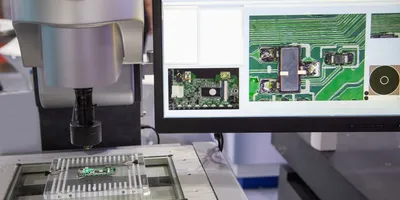Industrial Surface Defect Detection Through Advanced AOI Systems and Machine Vision
In today’s ultra-competitive manufacturing landscape, delivering flawless products isn’t just an aspiration—it’s a prerequisite. Across automotive, electronics, wood, glass, and semiconductor industries, even the slightest surface blemish can render a product unsellable or unsafe. Enter the transformative synergy of industrial surface defect detection, machine vision systems, and modern AOI systems—technologies that are rewriting the rules of visual inspection.
Why Precision Defect Counting Matters
Manufacturers historically struggled to detect—and count—defects with consistency. It’s not enough to know whether a flaw exists; precise counts, especially within critical zones, determine whether a product passes or fails.
- Grade and Compliance: Many industries permit only a limited number of scratches or particles within designated zones. Exceeding that limit—even by one—may downgrade a product.
- Root-cause identification: Sudden upticks in specific defects—like a recurring crack—can indicate emerging equipment faults or material inconsistencies.
- Cost Savings: Early detection and classified defect rejection reduce wasted materials, rework, and recall risks.
- Customer Trust: Delivering consistently flawless products cements a brand’s reputation for quality.
In short, defect counting isn’t a mere checkbox—it’s a strategic advantage.
Region-Based Counting: A Game-Changer
Defect severity isn’t uniform across a product’s surface. Imagine a hairline crack in the center of a mobile device’s glass—far more consequential than a minor edge nick on the back casing. AOI systems equipped with region-based analysis empower manufacturers to focus scrutiny where it counts most.
Key advantages include:
- Zone-Specific Thresholds — Set defect limits per region: stricter for high-impact areas, looser for non-critical zones.
- Enhanced Precision — Isolated scrutiny eliminates false positives from neglecting critical regions.
- Smart Reject Logic — Reject or rework only when defects appear within sensitive zones—maximizing usable yield elsewhere.
- Operational Insight — Regional defect logs illuminate production hotspots needing attention.
The Power of Machine Vision Systems
Achieving zone-based accuracy hinges on a robust machine vision system—a coordinated ensemble of cameras, lighting, and AI.
High-Speed Imaging
- Line scan cameras capture continuous production lines—ideal for stream-fed glass panels or steel sheets.
- Area scan cameras snap static or slow-moving parts—great for circuit boards, molded plastic assemblies, or wood panels.
Configurable imaging allows systems to capture only relevant areas, optimizing speed and resolution.
Adaptive Lighting
Defect visibility relies heavily on lighting—reflections mar visibility, shadows hide flaws. Advanced systems employ:
- Diffuse lighting for even surface illumination.
- Directional lighting to reveal micro-scratches via shadow contrast.
- Backlighting to highlight cracks or discontinuities.
Lighting systems dynamically adjust based on material finish and detection requirements.
Intelligent AOI Software
Captured images flow into AOI systems powered by machine vision AI. These intelligent engines:
- Define regions of interest for zone-specific inspection.
- Detecting and classifying defects—scratches, pits, particles, discolorations, cracks—leveraging deep learning.
- Count defects per region, tallying high-severity flags separately.
- Trigger automated outcomes: pass, reject, alert, or re-route for rework.
- Log data—image evidence, counts, and outcomes—to build traceability and support SPC (Statistical Process Control).
This real-time, autonomous pipeline ensures inspection https://cubanribs.com/ and speed—far beyond traditional human methods.
From Data to Wisdom: AI-Powered Insights
Intelligence doesn’t end at detection. The same machine vision insights help companies:
- Spot trends—like upticks in particle defects following a change in material supplier.
- Run root-cause analysis when scratches spike after machinery overhaul.
- Enforce predictive maintenance, with rising defect counts signaling emerging issues.
- Fine-tune zones—tightening or relaxing thresholds based on usage patterns and failure impacts.
In short: data-driven quality control becomes actionable process governance.
Industry-Wide Deployment Examples
This trifecta of industrial surface defect detection, machine vision system, and AOI system is transforming sectors:
| Industry | Use Case | Benefit |
| Automotive | Inspect paint and weld joints on body panels. | Catch scratches and delamination before assembly. |
| Electronics | Examine PCB areas for solder or component defects. | Prevent malfunction-causing flaws. |
| Glass & Wood | Scan center and edge zones for cracks or knots. | Optimize yield, reduce rejects. |
| Semiconductor | Inspect wafers for micro-cracks or contamination. | Improve process yield in fabs. |
| Pharmaceutical | Check blister packs for cracks or missing capsules. | Avoid recalls and contamination risks. |
The approach is flexible—inspecting a car door’s weldline, wood panel knots, or tiny labels in blister packs with equal ease.
Technology Stack: Cameras to Cloud
Cameras & Optics
- Line scan (2K to 16K) and area scan cameras capture fine detail.
- Specialized lenses ensure field-of-view matches product size.
- Frame grabbers (CoaXpress, 10G, GigE) ensure high data throughput.
Lighting
- Programmable illumination rigs adapt to materials, surfaces, and inspection zones.
- Systems calibrate lighting per inspection routine for maximal defect contrast.
AI & Software
- Intelgic’s Live Vision AI engine allows easy zoning, threshold adjustments, and continuous self-improvement through defect training.
- Cloud dashboards aggregate inspection data across lines, factories, and time—feeding analytics and KPI systems.
Integration
AOI systems plug into MES, ERP, or SCADA platforms—raising defect logs into real-time production control and traceability frameworks.
Deploying a Cutting‑Edge AOI System: Step-by-Step
1. Zone Identification
Analyze product areas most critical to function or appearance (e.g., PCB pads, car window area, blister packaging).
2. Camera & Lighting Planning
Select optics and lighting based on zone dimension, surface type, and production speed.
3. AI Model Training
Collect images containing real defects and acceptable variations—covering each zone.
4. Threshold Tuning
Define acceptable defect counts per zone—tighten only where required.
5. System Line Integration
Deploy AOI into production lines or manual inspections with real-time feedback.
6. Monitoring & Optimization
Review defect trends, retrain AI models, and refine zoning or thresholds over time.
Quantifying the Benefits
- 100× improved consistency—AI doesn’t tire, skip frames, or lose focus.
- 5–10× faster inspections compared to manual checks.
- 10–20% reduction in rework and scrap thanks to early localized detection.
- Maintenance costs drop by up to 15% by catching equipment wear early.
- Compliance and audit readiness with traceable inspection records and zone logs.
Future Horizons in Defect Detection
Emerging technologies are expanding this frontier:
- 3D surface mapping—using depth sensors to detect warp, dents, or curvature defects.
- Edge AI processing—running inference directly on cameras for ultra-fast feedback.
- Predictive analytics—using cloud-collected defect data to forecast failure trends weeks ahead.
- Robotic sorting—pairing detection systems with actuators to remove defects autonomously.
In modern manufacturing, surface flaws aren’t just cosmetic—they’re critical quality fail points. By combining industrial surface defect detection with an advanced machine vision system and a robust AOI system, businesses elevate inspection from an afterthought to a strategic advantage.
Precision defect counting within regions yields tangible value—higher yield, smarter maintenance, and unshakable brand trust. Whether you’re building sleek cars, printed circuit boards, wood furniture, or packaged pharmaceuticals, AI-powered zone-specific inspection gives you control, clarity, and competitiveness.
The future of quality assurance lies in systems that see deeply, decide precisely, and learn continuously.







